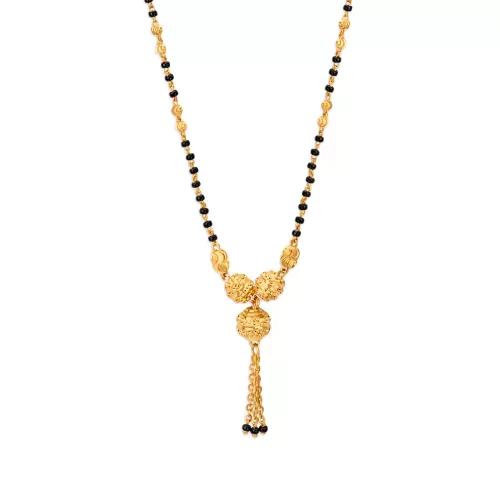Unveiling the Rich Symbolism and Modern Twists of Mangalsutra
The history and significance of mangalsutra in Indian culture
Mangalsutra is a traditional necklace worn by married women in India. The word “mangalsutra” is derived from two Sanskrit words, “mangal” which means auspicious and “sutra” which means thread or cord. It is a symbol of a married woman’s status and is believed to bring good luck and long life to her husband. The origins of mangalsutra can be traced back to ancient times when a woman tied a thread around her husband’s neck as a symbol of their union. Over time, the thread evolved into a necklace made of black and gold beads. Today, mangalsutra is an essential part of Indian weddings and is worn by women as a sign of their commitment to their husbands.

Different types of mangalsutra designs and their meanings
There are various types of mangalsutra designs in India, and each has its own unique meaning. The most common design is the “thaali” or “mangalyam” style, which is a simple chain with a pendant. Another popular design is the “vati” style, which consists of small gold or black beads arranged in a specific pattern. The “tanmaniya” style is a delicate necklace with a diamond pendant, while the “pustelu” style is a long necklace with a large gold or silver pendant. Each design has its own cultural and religious significance and is worn by women in different regions of India.
How to choose the perfect mangalsutra for your wedding
Choosing the perfect mangalsutra for your wedding is a significant decision. The design, style, and material of the mangalsutra should reflect your personality and personal preferences. When selecting a mangalsutra, consider the length and weight of the necklace, the type of metal and beads used, and the design of the pendant. You should also take into account the cultural and religious significance of the mangalsutra and choose a design that reflects your beliefs and values.
The importance of wearing a mangalsutra even after marriage
In Indian culture, mangalsutra is worn by married women as a sign of their marital status and commitment to their husbands. It is believed that wearing a mangalsutra brings good luck and long life to both the husband and wife. Additionally, it serves as a symbol of love, trust, and respect between a husband and wife. Even after many years of marriage, wearing a mangalsutra can help strengthen the bond between a husband and wife.
Modern twists on traditional mangalsutra designs
In recent years, there has been a trend towards modernizing traditional mangalsutra designs. Many designers are creating contemporary mangalsutra designs that incorporate diamonds, colored gemstones, and other modern materials. These modern twists on traditional designs allow women to express their individuality while still honoring their cultural and religious traditions
The role of mangalsutra in interfaith marriages
Mangalsutra is an essential part of Indian culture and is deeply rooted in Hindu traditions. However, in interfaith marriages, the role of mangalsutra can be a source of conflict or confusion. Some couples choose to incorporate both partners’ cultural traditions into the mangalsutra design, while others opt for a more neutral design that reflects both partners’ beliefs.
How to care for your mangalsutra to keep it looking beautiful
To keep your mangalsutra looking beautiful, it is essential to care for it properly. Avoid exposing your mangalsutra to harsh chemicals or abrasives, and store it in a safe, dry place when not in use. Regular cleaning with a soft cloth and mild soap can help remove dirt and oils and keep your mangalsutra looking shiny and new.

The symbolism behind the black and gold beads used in mangalsutra
The black and gold beads used in mangalsutra have significant cultural and religious symbolism. The black beads are believed to ward off evil spirits and protect the marriage, while the gold beads represent prosperity and wealth. In some regions, the number of black and gold beads used in the mangalsutra has specific meanings, such as seven or nine beads representing the seven or nine vows taken during the wedding ceremony.
The tradition of exchanging mangalsutra during the wedding ceremony
In many Indian weddings, the groom presents the bride with the mangalsutra during the wedding ceremony. This exchange of mangalsutra symbolizes the couple’s commitment to each other and is a significant moment in the wedding ceremony. The groom ties the mangalsutra around the bride’s neck with three knots, each knot representing a promise to honor, cherish, and protect the bride.
The cultural significance of mangalsutra in other countries and cultures
Although mangalsutra is most commonly associated with Indian culture, similar necklaces with cultural and religious significance can be found in other countries and cultures. For example, in Nepal, a married woman wears a necklace called a “mangalsutra” or “thaali,” which is similar to the Indian mangalsutra. In Indonesia, married women wear a necklace called a “gigi balang,” which is believed to protect the marriage. The cultural significance of these necklaces varies, but they all serve as a symbol of a woman’s marital status and commitment to her husband.

In conclusion, the mangalsutra is a beautiful and meaningful symbol of love, commitment, and fidelity. It is a reminder of the vows that were exchanged on the wedding day, and it is a symbol of the hope and promise for a happy and fulfilling future together. The mangalsutra is a precious gift that should be cherished by both the husband and wife. It is a reminder of the love and respect that they share, and it is a symbol of their commitment to each other.
